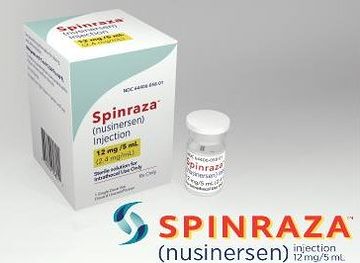Biogen’s Spinraza Surpassing Expectations as More Insurers Cover It or Relax Coverage Restrictions
Written by |

Spinraza, SMA's first disease-modifying therapy.
Biogen’s Spinraza (nusinersen), an expensive but lifesaving medication for thousands of babies born with spinal muscular atrophy (SMA), is becoming available to more and more Americans as private and government health insurers either cover it or ease coverage restrictions.
Eighty percent of Americans with private health insurance, and 60 percent of those covered by state Medicaid plans, are now able to obtain Spinraza if they need it.
Another indication of its momentum is that 233 sites across the United States have taken steps to administer Spinraza, with 145 of the sites already dosing it.
Unsurprisingly, Spinraza sales are helping Biogen’s bottom line. The Boston-based pharmaceutical company reported second-quarter revenue of $3.1 billion, including Spinraza sales of $203 million — nearly three times the $70 million Wall Street analysts had predicted.
In a post-earnings conference call, Biogen CEO Michel Vounatsos said Spinraza could become one of his company’s “largest commercial assets, shifting the center of gravity for Biogen beyond MS [multiple sclerosis].”
Advocacy groups are having growing success persuading insurers to expand coverage for the treatment, which won U.S. Food and Drug Administration approval in December 2016.
Priced at $750,000 for the first year of use and $375,000 a year after that, Spinraza is one of the world’s costliest medications. But SMA is the top genetic killer of American infants, occurring in anywhere from one in 6,000 to one in 10,000 U.S. births. And Spinraza is the first approved therapy that targets the underlying genetics of SMA rather than just its symptoms.
In laboratory tests and animal studies, Spinraza increased the production of a functional SMN protein. It did this by targeting the process by which a gene called survival motor neuron 2, or SMN2, generates the protein. In the Phase 3 ENDEAR clinical trial (NCT02193074), 51 percent of infants with type 1 SMA receiving Spinraza achieved mobility milestones, such as being able to sit unassisted, roll and control their heads.
CHERISH (NCT02292537), also Phase 3, investigated the effectiveness of Spinraza versus a placebo in 126 children who were diagnosed with SMA after 6 months of age. That study found that 61 percent of treated infants were alive and did not require ventilation more than 16 hours a day.
“Spinraza was approved with very impressive effectiveness data, so its success doesn’t come as a surprise to us,” Paul Melmeyer, director of federal policy at the National Organization for Rare Disorders, told SMA News Today in a phone interview from Washington.
“It really is a testament to the opportunities for innovation within the orphan drug space for making such a huge difference in the lives of patients with rare diseases,” he said. “This shows the importance of orphan therapies — especially for patients such as those with SMA who do not have alternate treatments.”
An orphan drug is one developed to treat a rare disease.
In a May 4 webinar, Kenneth Hobby, president of the Chicago-based advocacy group Cure SMA, said that each of the medical sites that are administering Spinraza can manage only 25 to 50 patients because of the need for repeat dosing.
Access to the therapy is also limited partly because Spinraza must be administered through a spinal tap at specialized facilities. Doctors inject it through the lower back directly into a baby’s central nervous system.
More than 170 commercial insurance plans have approved the drug, Biogen said. This means more than 80 percent of people with private health coverage have access to it.
Furthermore, 28 state Medicaid boards are covering Spinraza. This makes it available to 60 percent of state Medicaid members.
Another piece of good news is that about 70 percent of commercial and 60 percent of Medicaid policies have few, if any, restrictions on the type of SMA patients have, or their age. Cure SMA said the 40 percent of Medicaid policies with more restrictions represent “opportunities for continued advocacy” by its supporters.
“Already, we have seen the positive impact of this advocacy, from both commercial and Medicaid payers. In June, Anthem [insurance company] issued a revised policy removing many of the restrictions that were part of their initial policy,” Cure SMA said in a July 26 statement.
Anthem’s revised policy expanded its coverage to children who develop SMA-associated symptoms before 21 months of age. Previously, the company limited coverage to children who develop symptoms at six months or younger.
The North Carolina Medicaid Board — which initially adopted a restrictive policy — is also considering revising its criteria to make Spinraza available to anyone with a genetic diagnosis of SMA, regardless of type or age.
In addition to the United States, Spinraza has been approved in Canada, Japan and 28 European Union countries. Filings are pending in Australia, Brazil, Israel, South Korea and Switzerland.
During their conference call with analysts, Biogen executives said Spinraza — which was developed in a collaborative effort with Ionis — is a model for the types of drugs and deals that the company hopes to pursue.
Melmeyer of the National Organization for Rare Disorders said Spinraza’s market success could indeed inspire other treatments. “Maybe this is the first of many drugs for SMA, and the existence of Spinraza will accelerate the development of other therapies,” he said.
He warned, however, that in light of the healthcare debate in Congress, “cutting Medicaid funding by hundreds of billions of dollars and compromising protections for individuals with pre-existing conditions would jeopardize access to these very innovative therapies. While orphan drugs aren’t directly touched, if we take away health insurance from millions of individuals, they’re not going to be able to access these therapies at all.”






